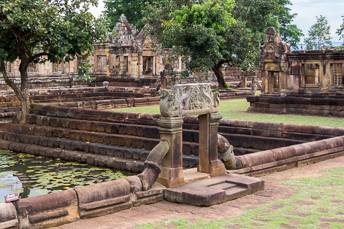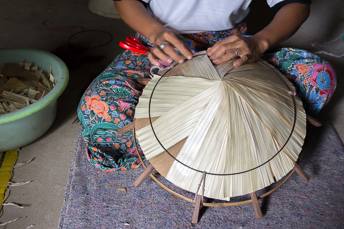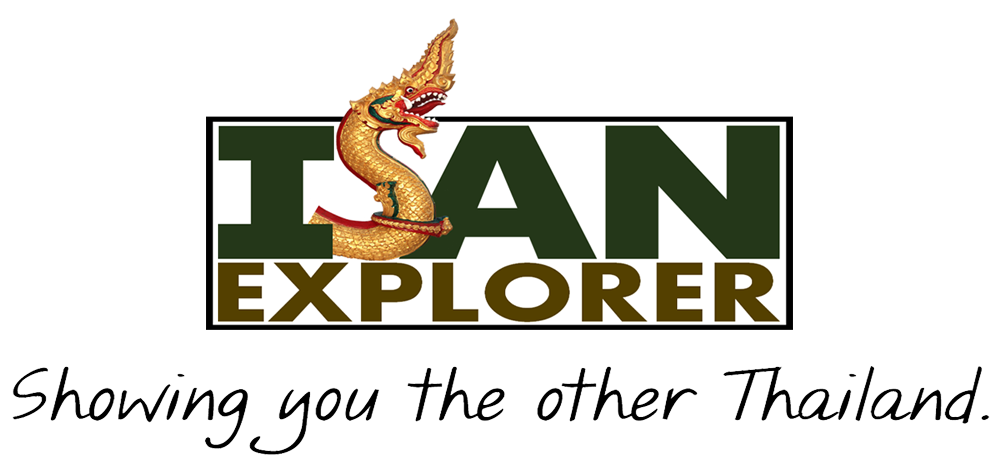Absolute Isan Tour


Duration
10 Days
Start/Finish
Khon Kaen to Khon Kaen
Highlights
• Vivid Ban Chiang pottery
• The immense, bizarre sculptures at Sala Kaew Ku
• Mountain scenery along the Mekong River
• Wandering the cliffside walkways at Wat Phu Tok
• Wat Phra That Phanom, the holiest temple in Isan
• Historic Isan-style Buddhist temples
• Bathing an elephant in the river
• Evocative Khmer ruins of Phanom Rung and Muang Tam
• Seeing pottery made using ancient methods
• Seeing how silk is made
Description
Combining destinations from our Northern Isan and Southern Isan tours, this is one of our most diverse trips. We begin at Ban Chiang, one of Southeast Asia’s most important archaeological sites. Then, after seeing the surreal Sala Kaew Ku sculpture park and other sites in Nong Khai city, we’ll head east along the Mekong River to explore the cliffside walkways at Wat Phu Tok and look for wild elephants in the Phu Wua Wildlife Reserve. We continue along the Mekong past dinosaur footprints, historic temples that are sure to wow art lovers, a house where Ho Chi Minh once lived, and the bizarre eroded rock formations of Phu Pha Thoep National Park. Then we leave the Mekong behind to visit a temple where the buildings are made of old bottles, see some French colonial-style architecture, swim with elephants in a river, and explore the exquisite Khmer ruins of Phanom Rung and Muang Tam. On the final day we’ll see the old city gate and other interesting monuments in Nakhon Ratchasima city, pottery made using traditional methods, and the process of making silk fabric from worm to loom.
From around November to February, we can adjust the itinerary so you can take a boat ride through the vast spread of pink water lilies in Tale Bua Dang, the “Red Lotus Lake.”
About Elephant Tourism
Elephant tourism is rightly controversial, though we worked with the renowned Save Elephant Foundation to ensure that our tours are not only responsible, but actually beneficial to the elephants involved. Click here to read how.
Add-Ons
Make the most of your trip with our special add-on activities before, during, or after your tour.

Day 1 – Ban Chiang
On the way north from Khon Kaen we will stop to meet the urban monkeys that live in Kumphawapi’s town center and visit a weaving village before heading to Ban Chiang, the site of an enigmatic civilization that began making bronze tools around 2000 BC; long before any other known place in East Asia. The myriad artifacts unearthed here, most famously the iconic burnt ocher swirl pottery, rewrote the history books and today can be seen both inside the excellent Ban Chiang National Museum and in situ at a burial ground excavation site. We’ll also see how sticky rice baskets are woven. Then it’s up to Nong Khai city, on the Mekong River, where we’ll walk through the popular Tha Sadet Market, filled with bric-a-brac from Thailand, China, and other countries.
Overnight in Nong Khai
Day 2 – Sala Kaew Ku & Bueng Kan
The highlight of your morning tour of low-key Nong Khai is Sala Kaew Ku, a wonderfully bizarre religious center filled with immense and strange concrete sculptures blending Buddhist and Hindu iconography. We’ll also see some incredible Buddhist temple murals, including the well-known ones at Wat Pho Chai. We’ll then turn east and follow the Mekong River, often on small country roads, with stops to see a temple honoring naga (magical serpents) and the scenic red boulders at Ban Ahong, just upriver from Bueng Kan city.
Overnight in Bueng Kan
Day 3 – Wat Phu Tok & Ban Kham Pia
We’ll begin the day in a village seeing how thatch roofs are made before climbing and exploring the labyrinth of walkways at Wat Phu Tok, a temple built on a mountain plateau with wooden platforms leading along the cliffs. Then, based on your preference, we’ll either trek up to a soaring clifftop viewpoint in the Phu Wua Wildlife Reserve or spend a few hours strolling around a typical agricultural village seeing local life up close – or do a little of both. We’ll arrive in Bung Khla, our overnight stop, early enough to fully enjoy the incredible views of the mountain-lined Mekong River here.
Overnight in Bung Khla
Day 4 – Tha Uthen & Nakhon Phanom
Heading south, we’ll stop to see some amazing wood carving and dinosaur footprints before taking a break to enjoy lunch with the peaceful scenery of the Two-Coloured River, where the greenish Songkhram River joins the muddy brown Mekong. Further downriver we’ll see the soaring 66-meter (217 feet) tall Phra That Tha Uthen stupa and ogle the impressive variety of local foods for sale in the Tha Uthen market. Sticking to country roads hugging the Mekong, we’ll see hats made from bamboo husks and walk over a rickety bamboo bridge to a small island (accessible at the end of the dry season only). It’s then down to Nakhon Phanom, a very laid-back capital city with beautiful mountain views. There we’ll visit a fabric weaving group, go to the local museum to see examples of the “fire boats” that grace the river at the end of the Buddhist lent, and enjoy some marvelous modern temple murals.
Overnight in Nakhon Phanom
Day 5 – That Phanom
Probably the highlight of time spent in Nakhon Phanom is watching the sun rise behind the mountains across the Mekong River in Laos, which you can choose to watch from your hotel room or along the riverside promenade. On the way down to little That Phanom, home to the holiest temple in Isan, we’ll stop to visit a replica of the house Ho Chi Minh lived in during his time here and a basket weaving village, where, if you wish, you can get advice from a local spirit medium. In That Phanom town we’ll see a Buddhist temple with historic murals and stroll down a well-preserved block of French-Indochina style buildings to a large symbolic arch, similar to Patuxai in Vientiane, before arriving at the famous Phra That Phanom, a gleaming white 53-meter (174 feet) stupa, topped with a 16-kilogram (35 pounds) jewel-encrusted gold parasol.
Overnight in That Phanom
Day 6 – Mukdahan
As we follow the river south to Mukdahan, we’ll make a quick stop at Kaeng Kabao, a dry-season-only stretch of rapids and islets on the Mekong River before visiting the contemporary Our Lady of the Martyrs of Thailand church, built to commemorate seven Thai Catholics executed in 1940 by the police for refusing to renounce their faith. Then we’ll sample a variety of traditional snacks made on-site by a women’s cooperative. Next up are two old temples with well-preserved historic buildings that will delight even casual art lovers and we’ll say hello to some local monkeys in a small patch of forest. In Mukdahan city, we’ll climb Ho Kaeo Mukdahan, a 65 meter-tall (213 foot) tower built to mark the king’s 50th year on the throne. It has a good museum and great views. Phu Pha Thoep National Park’s main attraction is a field full of mushroom-shaped rock pillars. We’ll finish the day back in the city at Mukdahan’s large Indochina Market.
Overnight in Mukdahan
Day 7 – Yasothon
This morning we leave the Mekong River behind and head through seemingly endless rice paddies. The first two stops are a Catholic church built of wood and a Buddhist temple built with old bottles. After visiting a basket-making village we’ll see a pair of historic wooden Buddhist scriptures libraries (haw-dtrai) built in the middle of ponds to keep termites at bay. We’ll then stroll one of the last remaining blocks of French colonial-style architecture in Thailand and a market where many of the products for sale are gathered in the surrounding forest. After visiting the ancient Ku Phra Kona Khmer temple ruin, which has been converted into a modern Buddhist shrine and hosts a troop of semi-tame monkeys, we’ll roll into the little riverside town of Tha Tum.
Overnight in Tha Tum
Day 8 – Elephant Village & Surin
Ban Ta Klang is home to the Kui (aka Suai) people, Thailand’s legendary elephant handlers, and about 150 elephants live side-by-side with them at their homes in the village. We will spend the morning getting up close and personal with elephants by walking with them to the Mun River where we can jump in to help the mahouts bathe them. We’ll then visit the elephant museum and see the elephant cemetery. We will say good bye to our pachyderm friends by feeding them some fresh fruits or vegetables. Surin province is just as renowned for its handicrafts as it is for its elephants and after we bid farewell to them, we will visit a workshop to see Khmer-style silver beads and other products being made by hand. The most expensive silk fabric in Thailand, popular with the royal family, of course, is made in Ban Tha Sawang village. The exquisite brocade cloth (called paa yok tawng) made here uses threads coated in gold and silver and is woven on a two-story-tall loom worked by four women simultaneously.
Overnight in Surin
Day 9 – Muang Tam & Phanom Rung
Today we will visit two of Thailand’s biggest and best Khmer ruins: Phanom Rung and Muang Tam. Crowning an extinct volcano with views all the way off to Cambodia and reached by a grand promenade, Phanom Rung is a brilliantly restored temple built mostly in the 12th century. The artistic detail is as beautiful as the entire structure is grand and it will impress you even if you’ve already visited Cambodia’s Angkor Wat. Down below Phanom Rung is Muang Tam, a smaller but also impressive and excellently restored ruin that retains some wonderful carvings. Being on flat ground, it follows a more typical layout (the same as Angkor Wat) and the complex is surrounded by four lotus-filled pools. Between the two temples is a village that weaves reed sitting mats. Near Khorat city, Dan Kwian village has been producing pottery for hundreds of years. The original rough, rust colored products are still made, along with a great variety of vibrant modern designs. We’ll visit a seemingly timeless workshop with its giant wood-fired kilns and hit a few stores to see the finished products.
Overnight in Khorat
Day 10 – Khorat & Ban Prasat
Nakhon Ratchasima is a bustling modern city, though its moat and city fortifications still stand as evidence of its long history. We’ll start by admiring Wat Pa-Yap, which has a shrine encrusted with stalactites, stalagmites, and other beautiful rocks rescued from a cave that was destroyed during the excavation of a quarry. Then we’ll join the devotees at the very holy Thao Suranari Memorial, built in honor of a woman who, according to legend, devised and led a prisoner rebellion against the invading Lao army (One version says that the women seduced the soldiers and then the men launched a surprise attack.) in 1826, thus saving the city. Performers do a local folk dance throughout the day to thank “Grandma Mo” for wishes people think she has answered. Many of the lovely buildings at nearby Wat Salaloi, founded by Thao Suranari and her husband, are decorated with Dan Kwian ceramic tiles. Outside the city we’ll stop to see pottery of a completely different kind from the day before. Women here hand make perfectly round clay cooking pots and water containers using the ancient paddle and anvil method rather than a potter’s wheel. In Ban Prasat, on the way back to Khon Kaen, we’ll see the remains of an ancient agrarian culture in three excavated burial sites displaying skeletons and pottery in situ. Then we’ll visit two villages to see how reed sitting mats are made and see the entire silk weaving process: raising silkworms, spinning silk thread, and hand-weaving mut-mee fabric. If you want, you can sit at a loom and try it yourself. Then we’ll stop to admire a historic little temple building featuring original Isan-style murals, which are now very rare, before arriving back in Khon Kaen.
If our itinerary doesn’t fit your exact needs and desires, please let us know. With advance notice we can usually modify things.
Prices valid until March 2025.
| Hotel Level | Number of Persons | ||||||||
| Price per person, two per room (baht) | |||||||||
| 1 | 2 | 3 | 4 | 5 | 6 | 7 | 8 | 9+ | |
| Budget | 112,100 | 56,550 | 40,150 | 30,600 | 26,350 | 22,450 | 20,400 | 18,250 | By Request |
| Deluxe | 121,850 | 61,600 | 46,600 | 35,550 | 32,150 | 27,350 | 25,950 | 23,100 | |
| Homestay | 112,300 | 58,200 | 41,100 | 32,100 | 27,450 | 23,900 | 21,600 | 19,650 | |
Price Includes
All sightseeing and activities as specified in the itinerary with English-speaking local guides, entrance fees, transportation in an air-conditioned vehicle, hotel transfers, accommodation, breakfast at deluxe-level accommodation and village homestays, dinner at village homestays, snacks and cold water in the vehicle, accident insurance, taxes, and pre-departure travel consultation.
Price Does Not Include
Transportation to Khon Kaen, meals and drinks other than what is specified above, travel and medical insurance, personal expenses (such as laundry, souvenirs, snacks, etc.), tips/gratuities, visa fees (Thai visas are free or not required for most international visitors.), and any additional expenses incurred due to airline schedule changes, natural disasters, political actions, or other factors beyond our control.
Booking/Cancellation Policies
• For tours longer than one day, a non-refundable deposit of 30% is required as soon as possible after making your reservation.
• The full payment is due before the tour begins. This can be done after you arrive in Thailand, as long as you have access to sufficient funds before you depart on your tour.
• International payments are best done by bank transfer, and the cheapest, fastest, and easiest way is with TransferWise. Credit/debit cards can be used through TransferWise or other online wire transfer services. For people inside Thailand, we accept payment via cash (Thai baht, US dollars, British pounds, and euros), ATM transfer, and counter deposit to Siam Commercial Bank.
• If local taxes and/or fuel prices increase significantly, we reserve the right to add comparable surcharges.

This is the accommodation that we normally use for this tour. Of course, if any place is fully booked during your travel dates, we will have to substitute a similar property. If this happens, we will let you know right away.
Click here to see a general description of our accommodation levels.
Day 1 – Nong Khai
Budget: Mut Mee Garden Guesthouse
Deluxe: Mut Mee Garden Guesthouse -or- Pimali*
Homestay: Ban Prao village homestay
Day 2 – Bueng Kan
Budget: Rachawadee Hotel
Deluxe: The One Hotel
Homestay: Ban Ahong village homestay
Day 3 – Bung Khla
Budget: Mon Prasit Resort
Deluxe: Mon Prasit Resort
Homestay: Ban Kham Pia village homestay
Day 4 – Nakhon Phanom
Budget: P Hometel
Deluxe: The River Hotel
Homestay: Thai Sak Homestay (Ban At-Samat village)
Day 5 – That Phanom
Budget: Baan Ing Oon Guesthouse
Deluxe: Riverview Hotel
Homestay: Baan Ing Oon Guesthouse
Day 6 – Mukdahan
Budget: Riverview Maekhong Hotel
Deluxe: Riverfront Hotel
Homestay: Riverview Maekhong Hotel
Day 7 – Tha Tum
Budget: Srithongkul Riverside Hotel
Deluxe: Srithongkul Riverside Hotel
Homestay: Ban Nong Bua village homestay
Day 8 – Surin
Budget: Maneerote Hotel
Deluxe: Surin Majestic Hotel
Homestay: Baan Chang Ton
Day 9 – Khorat
Budget: Romyen Garden Place
Deluxe: Kantary Hotel
Homestay: Romyen Garden Place
*These hotels offer very different styles. We let you choose the one that’s right for you.
